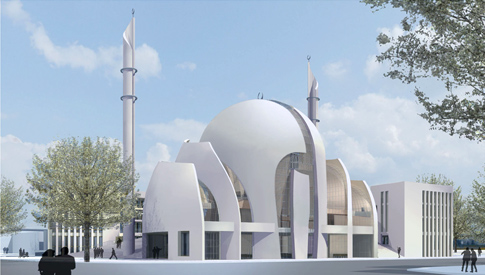

 3D-Visualisierung der geplanten Zentralmoschee in Köln, Stand: Oktober 2008 The structures on the Temple Mount in Jerusalem reflect the changing history of Judaism, Islam and Christianity; at the same time, it is, together with the city of Jerusalem, the best known symbol of the longstanding, politically and religiously motivated conflict in the Near East. A similar conjunction of religion, politics and architecture has also been on view in Cologne. Out of their concern about a growing islamisation, citizens’ initiatives have been trying to prevent the planned erection of a central mosque there: the mosque has become the metaphor for a general fear of foreign infiltration, which fails to recognise that Islam has long since become a part of German identity. Cologne cathedral, the historical trademark of the city, is one of the largest gothic cathedrals and is crucially important for the Catholic Church; it is, however, also an early symbol of a German national consciousness, which formed in the 19th century. It displays, therefore, the arguably perfect antagonist in the debate about the building of the central mosque, in which houses of prayer furnish symbols for ways of looking at the world and for political programmes and flashpoints for cultural conflicts.  Debate on Cologne Mosque project Debate on Cologne Mosque projectdocumentary material (architectural designs, photographs, graphics, texts) courtesy Architekturbüro Paul Böhm, DITIB/Türkisch-Islamische Union der Anstalt für Religion e.V. und die Bürgerbewegung Pro Köln e.V.
|